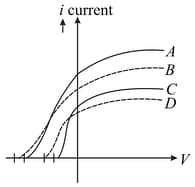EASY
JEE Main/Advance
IMPORTANT
Earn 100
Choose the correct statements regarding the phenomena of photoelectric effect
(a)Photoelectric effect was explained by Einstein considering wave nature of light
(b)If intensity of radiations incident on photosensitive material is increases, stopping potential increases
(c)Work function of gold is about
(d)Slope of a graph between incident frequency (greater than threshold frequency) verses stopping potential is independent of metal
50% studentsanswered this correctly

Important Questions on Dual Nature of Radiation and Matter
MEDIUM
JEE Main/Advance
IMPORTANT
The figure shows the results of an experiment involving photoelectric effect. The graphs and relate to a light beam having different wavelengths. Select the correct alternative

EASY
JEE Main/Advance
IMPORTANT
Choose the correct alternative.
MEDIUM
JEE Main/Advance
IMPORTANT
When a metallic surface is illuminated with monochromatic light of wavelength then stopping potential for photoelectrons comes out . When the same metallic surface is illuminated with a light of wavelength then stopping potential becomes . If is threshold wavelength for the metallic surface and is the work function of the metal, then
MEDIUM
JEE Main/Advance
IMPORTANT
A metal surface is irradiated by light of wavelength,. The most energetic emitted photoelectrons are bent in a circle of radius by a magnetic field of T perpendicular to the velocity. Then
EASY
JEE Main/Advance
IMPORTANT
A point source of light emitting power is placed inside at the center of a soap bubble of radius Surface of soap bubble is perfectly absorbing and is the atmospheric pressure. If is the radiation pressure on the surface of soap bubble due to point source and is the net pressure inside the soap bubble having surface tension , then choose the correct answer is the speed of light)
MEDIUM
JEE Main/Advance
IMPORTANT
A beam of light of intensity is incident on a plane mirror and get reflected fully as shown in figure. The pressure exerted by beam on the mirror is ( : speed of light)

EASY
JEE Main/Advance
IMPORTANT
A photosensitive metal plate is exposed to a monochromatic light beam of frequency which is more than threshold frequency. Then plot of versus , is best represented by No. of photoelectrons, kinetic energy of photoelectron]
EASY
JEE Main/Advance
IMPORTANT
When light of wavelength is incident on a metal surface, the stopping potential is found to be . When light of wavelength is incident on the same metal surface, the stopping potential is found to be . The cut off wavelength for the metal is given by
